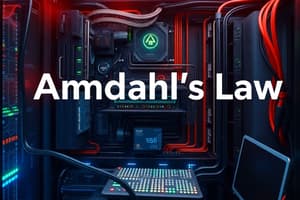Podcast
Questions and Answers
What kind of models suggest that reading aloud involves a network of interconnected processing units?
What kind of models suggest that reading aloud involves a network of interconnected processing units?
- Parallel-Distributed-Processing (PDP) models (correct)
- Lexical models
- Dual-Route models
- Non-lexical models
What is another name for Parallel-Distributed-Processing models?
What is another name for Parallel-Distributed-Processing models?
- Connectionist models (correct)
- Dual-route models
- Lexical models
- Non-lexical models
According to PDP models, how is information represented?
According to PDP models, how is information represented?
- In explicit rules
- By patterns of activation across many interconnected processing units (correct)
- In lookup tables
- In a single, localized representation
What is a key feature of PDP models regarding learning?
What is a key feature of PDP models regarding learning?
Which of the following is a characteristic of PDP models?
Which of the following is a characteristic of PDP models?
Which aspect of PDP models aligns with our understanding of brain function?
Which aspect of PDP models aligns with our understanding of brain function?
According to Coltheart (2005), which model was considered superior for simulating patterns of acquired and developmental dyslexia?
According to Coltheart (2005), which model was considered superior for simulating patterns of acquired and developmental dyslexia?
Why are irregular words read slower than regular words, according to the DRC model?
Why are irregular words read slower than regular words, according to the DRC model?
How does the DRC model explain the frequency effect?
How does the DRC model explain the frequency effect?
What did the Forster & Chambers (1973) study conclude about naming time?
What did the Forster & Chambers (1973) study conclude about naming time?
What does the Forster & Chambers (1973) study suggest about the pronunciation of a word?
What does the Forster & Chambers (1973) study suggest about the pronunciation of a word?
What does the Forster & Chambers (1973) study challenge?
What does the Forster & Chambers (1973) study challenge?
According to the DRC model, what causes phonological dyslexia?
According to the DRC model, what causes phonological dyslexia?
According to the triangle models, what causes phonological dyslexia?
According to the triangle models, what causes phonological dyslexia?
According to the DRC model, what causes surface dyslexia?
According to the DRC model, what causes surface dyslexia?
According to triangle models, what causes surface dyslexia?
According to triangle models, what causes surface dyslexia?
What is reading defined as?
What is reading defined as?
What is a goal of the science of reading?
What is a goal of the science of reading?
What is the idea behind computational models of reading?
What is the idea behind computational models of reading?
What is acquired dyslexia (alexia)?
What is acquired dyslexia (alexia)?
What is developmental dyslexia?
What is developmental dyslexia?
What is the other procedure that accomplishes the transformation from print to speech, according to the broad theoretical consensus?
What is the other procedure that accomplishes the transformation from print to speech, according to the broad theoretical consensus?
Flashcards
PDP models
PDP models
Models that suggest reading involves interconnected processing units.
Another name for PDP models
Another name for PDP models
PDP models are also known as Connectionist models.
Information representation in PDP
Information representation in PDP
Information is represented by patterns of activation across many interconnected processing units.
Learning in PDP models
Learning in PDP models
Signup and view all the flashcards
Characteristic of PDP models
Characteristic of PDP models
Signup and view all the flashcards
Brain function and PDP models
Brain function and PDP models
Signup and view all the flashcards
Superior model for dyslexia
Superior model for dyslexia
Signup and view all the flashcards
Reading irregular words
Reading irregular words
Signup and view all the flashcards
Frequency effect in DRC model
Frequency effect in DRC model
Signup and view all the flashcards
Forster & Chambers study conclusion
Forster & Chambers study conclusion
Signup and view all the flashcards
Pronunciation speed from Forster & Chambers
Pronunciation speed from Forster & Chambers
Signup and view all the flashcards
Challenge to phonemic recoding
Challenge to phonemic recoding
Signup and view all the flashcards
Causes of phonological dyslexia (DRC)
Causes of phonological dyslexia (DRC)
Signup and view all the flashcards
Causes of phonological dyslexia (Triangle models)
Causes of phonological dyslexia (Triangle models)
Signup and view all the flashcards
Cause of surface dyslexia (DRC)
Cause of surface dyslexia (DRC)
Signup and view all the flashcards
Cause of surface dyslexia (Triangle models)
Cause of surface dyslexia (Triangle models)
Signup and view all the flashcards
Definition of reading
Definition of reading
Signup and view all the flashcards
Science of reading goal
Science of reading goal
Signup and view all the flashcards
Computational models of reading
Computational models of reading
Signup and view all the flashcards
What is developmental dyslexia?
What is developmental dyslexia?
Signup and view all the flashcards
Transformation from print to speech
Transformation from print to speech
Signup and view all the flashcards
Components of the non-lexical route
Components of the non-lexical route
Signup and view all the flashcards
Non-lexical route characteristics
Non-lexical route characteristics
Signup and view all the flashcards
Reliance of the non-lexical route
Reliance of the non-lexical route
Signup and view all the flashcards
Errors in the non-lexical route
Errors in the non-lexical route
Signup and view all the flashcards
Novel words in non-lexical route
Novel words in non-lexical route
Signup and view all the flashcards
Accessing mental lexicon
Accessing mental lexicon
Signup and view all the flashcards
Types of words in lexical route
Types of words in lexical route
Signup and view all the flashcards
Limitation of lexical route
Limitation of lexical route
Signup and view all the flashcards
Feedback influence in connections
Feedback influence in connections
Signup and view all the flashcards
Feedback in reading routes
Feedback in reading routes
Signup and view all the flashcards
Race condition in reading routes
Race condition in reading routes
Signup and view all the flashcards
Impact of time pressure on reading
Impact of time pressure on reading
Signup and view all the flashcards
Transparent vs opaque languages
Transparent vs opaque languages
Signup and view all the flashcards
Key effects in reading models
Key effects in reading models
Signup and view all the flashcards
Reading frequency and speed
Reading frequency and speed
Signup and view all the flashcards
Regular vs irregular words reading
Regular vs irregular words reading
Signup and view all the flashcards
Orthographic neighborhood effect
Orthographic neighborhood effect
Signup and view all the flashcards
Sounding like words
Sounding like words
Signup and view all the flashcards
Length of non-words and reading speed
Length of non-words and reading speed
Signup and view all the flashcards
Correct reading of irregular words
Correct reading of irregular words
Signup and view all the flashcards
Reading nonwords
Reading nonwords
Signup and view all the flashcards
Study Notes
Reading Models and Processes
- Parallel-Distributed-Processing (PDP) Models: Suggest that reading involves a network of interconnected processing units. Another name for these models is connectionist models.
- PDP information representation: Information is represented by patterns of activation across many interconnected processing units, not explicit rules or lookup tables.
- PDP learning: PDP models learn through experience and repeated exposure, not explicit rules.
- Distributed representation: A characteristic of PDP models, where information is not localized but spread across a network.
Reading and Brain Function
- Distributed processing: An aspect of PDP models that aligns with the understanding of brain function.
- Lexical route: Used for regular and irregular words, using visual word recognition and knowledge of associations between printed words and spoken words.
- Non-lexical route: Used for novel words and unfamiliar items, utilizing grapheme-phoneme correspondences.
Types of Dyslexia
- Phonological dyslexia: Caused by damage to the non-lexical route in the DRC model, or damage to orthography-to-phonology connections in triangle models.
- Surface dyslexia: Caused by damage to the lexical route, in accordance with the DRC model.
- Orthography-to-phonology connections: The processes that associate written words with pronunciation either via the non-lexical route (applying grapheme-phoneme rules) or the lexical route.
Reading Models: Processing Units and Rules
- Computational models: Aims to simulate human reading processes, often using computer programs.
- Grapheme-to-phoneme correspondences (GPC): Critical for pronunciation in the non-lexical route.
- Non-lexical route issues: Errors may result due to exceptions to grapheme-phoneme rules.
- Novel word processing with non-lexical route: The non-lexical route supports approximation of pronunciation for novel words.
- Lexical route usage: The lexical route primarily deals with familiar words.
- Non-lexical route processing speed: Has to work harder for longer non-words as it is computationally intensive, in contrast to applying rules, for faster and easier word access.
Reading and Time Pressure
- Time pressure errors: Under time pressure, regularized word errors or misinterpreting non-words for words may occur.
- Route usage distinction: The lexical route primarily deals with known words, while the non-lexical route is employed more for unfamiliar words.
Reading and Word Frequency
- Frequency effect: High-frequency words are read faster because they are more accessible in the mental lexicon through practice and repeated exposure.
- Irregular words: These words often have conflicting pronunciations that require the use of both routes.
Factors Affecting Reading Speed and Accuracy
- Orthographic neighborhood: The number of visually similar words can affect reading speed for non-words; words with similar visual appearances are recognized faster.
- Whole-word recognition (lexical route): Uses existing word knowledge and long-term memory for speedy word recognition.
- Print-to-sound correspondences: Assist in pronunciation determination, particularly when relying on the non-lexical route.
Memory and Reading
- Long-term memory: Used to store whole words in the lexical route, or the pronunciations associated with graphemes in the non-lexical route.
Studying That Suits You
Use AI to generate personalized quizzes and flashcards to suit your learning preferences.




